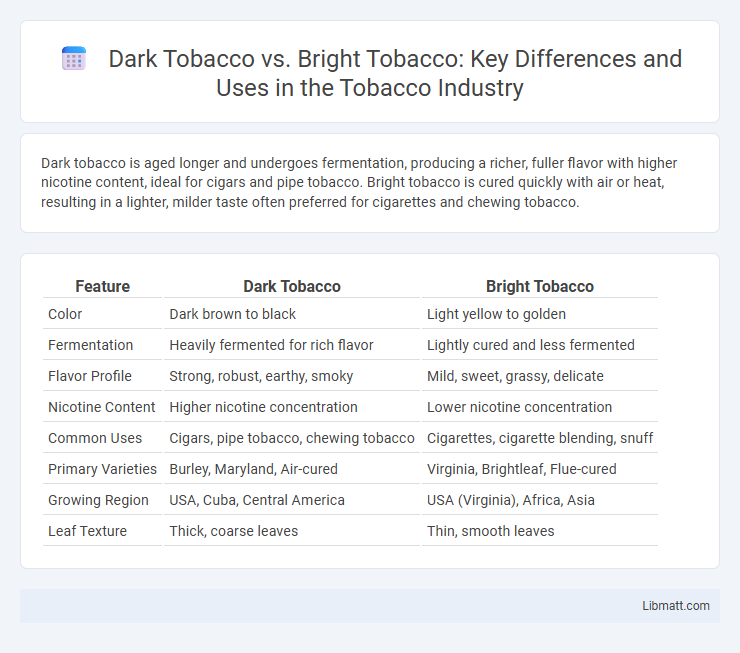Dark tobacco is aged longer and undergoes fermentation, producing a richer, fuller flavor with higher nicotine content, ideal for cigars and pipe tobacco. Bright tobacco is cured quickly with air or heat, resulting in a lighter, milder taste often preferred for cigarettes and chewing tobacco.
Table of Comparison
| Feature | Dark Tobacco | Bright Tobacco |
|---|---|---|
| Color | Dark brown to black | Light yellow to golden |
| Fermentation | Heavily fermented for rich flavor | Lightly cured and less fermented |
| Flavor Profile | Strong, robust, earthy, smoky | Mild, sweet, grassy, delicate |
| Nicotine Content | Higher nicotine concentration | Lower nicotine concentration |
| Common Uses | Cigars, pipe tobacco, chewing tobacco | Cigarettes, cigarette blending, snuff |
| Primary Varieties | Burley, Maryland, Air-cured | Virginia, Brightleaf, Flue-cured |
| Growing Region | USA, Cuba, Central America | USA (Virginia), Africa, Asia |
| Leaf Texture | Thick, coarse leaves | Thin, smooth leaves |
Introduction to Dark and Bright Tobacco
Dark tobacco, known for its rich, robust flavor and higher nicotine content, is primarily air-cured or fire-cured, resulting in a darker leaf color and stronger taste profile favored in cigars and pipe blends. Bright tobacco, typically flue-cured, offers a lighter, milder flavor with a golden hue, making it popular in cigarettes due to its smoothness and sweetness. Your choice between dark and bright tobacco depends on preferred flavor intensity and nicotine strength, catering to different smoking experiences.
Historical Origins and Global Distribution
Dark tobacco, originating primarily in the Americas, was traditionally air-cured or fire-cured to develop its rich, robust flavor favored in regions like the Appalachian Mountains and parts of Europe. Bright tobacco, known for its flue-cured method, emerged in the southeastern United States and quickly gained popularity worldwide due to its mild, sweet taste and lighter color, especially in cigarette production. Your understanding of these tobacco types' historical origins and global cultivation areas enhances appreciation for their distinct uses in various tobacco products.
Plant Varieties and Characteristics
Dark tobacco is typically grown from varieties such as Kentucky and Latakia, known for their robust, rich flavors and thicker leaves that undergo fermentation to enhance their smoky and sweet notes. Bright tobacco varieties, like Virginia and Burley, have thinner leaves characterized by a light, mild taste and higher sugar content, which results from curing processes that preserve their natural sweetness and bright color. The distinct plant genetics and curing methods between dark and bright tobacco directly influence their aromatic profiles and suitability for different tobacco products.
Growing Conditions and Agricultural Practices
Dark tobacco thrives in humid climates with rich, loamy soils, benefiting from extended sun exposure and frequent rainfall, which enhance its robust flavor and higher nicotine content. Bright tobacco, often grown in well-drained, sandy soils with controlled irrigation, requires precise agricultural practices to maintain its lighter color and milder taste. Your choice of tobacco depends on understanding these distinct growing conditions and how they influence the final product's quality and characteristics.
Curing Methods: Dark vs Bright Tobacco
Dark tobacco undergoes air curing and fire curing processes that involve drying the leaves slowly in controlled, often smoky environments to enhance rich, robust flavors essential for products like cigars and pipe tobacco. Bright tobacco, conversely, is flue-cured using indirect heat in controlled barns, resulting in a lighter, milder leaf with higher sugar content ideal for cigarettes. Understanding these distinct curing methods helps you choose tobacco that matches your flavor preference and smoking experience.
Chemical Composition and Nicotine Content
Dark tobacco contains higher levels of nicotine and essential oils due to its longer curing process, resulting in a richer, stronger flavor profile often preferred in cigars and pipe tobacco. Bright tobacco, typically flue-cured, has lower nicotine content and a lighter, milder taste, attributed to its higher sugar concentration and reduced alkaloid presence. The chemical composition differences directly impact the tobacco's combustion properties, aroma, and overall smoking experience.
Flavor Profiles and Aroma Differences
Dark tobacco offers rich, robust flavors with earthy, smoky, and sweet notes, often accompanied by a heavier, fuller-bodied aroma. Bright tobacco, conversely, features lighter, crisper flavors with grassy, citrusy, and floral undertones, producing a more delicate and aromatic scent. These distinct flavor profiles and aromas influence their preferred uses in cigars, pipe blends, and chewing tobacco, catering to varied taste preferences.
Uses in Cigars, Cigarettes, and Other Products
Dark tobacco features in cigars and pipe tobacco due to its rich, robust flavor and higher sugar content that enhances burning qualities. Bright tobacco is predominantly used in cigarettes because of its light, mild taste and high nicotine content, making it popular for commercial blends. Your choice between dark and bright tobacco influences the flavor profile and strength of products like cigars, cigarettes, and chewing tobacco.
Health Implications and Risk Comparison
Dark tobacco contains higher levels of nicotine and tar, increasing your risk of respiratory diseases and cancer compared to bright tobacco, which is often lighter and less processed. Studies indicate that smoking dark tobacco is linked to greater severity of chronic obstructive pulmonary disease (COPD) and cardiovascular issues due to its higher toxin concentration. Choosing bright tobacco may reduce some health risks, but all tobacco products carry significant dangers for lung and overall health.
Market Trends and Consumer Preferences
Dark tobacco dominates niche markets with a preference for robust, full-bodied flavor profiles favored by traditional cigar and pipe smokers. Bright tobacco appeals to a broader consumer base seeking smoother, milder tastes commonly found in cigarettes and chewing tobacco. Your choice between dark and bright tobacco should align with evolving market trends highlighting increasing demand for natural, less processed tobacco options.
Dark tobacco vs bright tobacco Infographic

 libmatt.com
libmatt.com